
by Laura Tiu | Mar 26, 2021
I am a curious person by nature. When I first moved to the Emerald Coast, I had many questions about the area. For example, why do they call this the Emerald Coast? To help answer my questions, I turned to the Destin History and Fishing Museum in Destin, FL. If you haven’t yet visited the museum, I highly recommend it for locals and visitors alike.
It was easy to see why they call this the Emerald Coast once one lays eyes on the beautiful emerald color water. Other questions weren’t so easily explained. For example, I wanted to know why the pass out of Destin Harbor is called the East Pass, when it is clearly on the west side of Choctawhatchee Bay? In fact, in the early 1900’s, the only outlet from the Bay to the Gulf was about 1.5 miles east of where the current pass resides and was called Old Pass Channel. In 1929, a storm sealed off Old Pass Channel and a heavy dose of spring rain raised Choctawhatchee Bay five feet. The threat of flooding inspired four local fishermen to take matters into their own hands and they dug a small trench across Santa Rosa Island to let the water out of the Bay. By the next morning, the trench had significantly widened into the East Pass we have today, connecting Choctawhatchee Bay to the Gulf of Mexico.
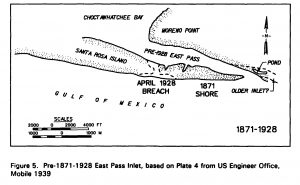
However, that still didn’t explain the East Pass moniker. To explain, we need to look west. Choctawhatchee Bay is connected to Pensacola Bay by the Santa Rosa Sound. This narrow passageway is the space between the Santa Rosa Island, a barrier island, and the mainland. In the early 1900’s, many of the goods and services traded between inhabitants in Okaloosa and Walton counties traveled on ships from Choctawhatchee Bay, through the Santa Rosa Sound, and over to Pensacola Bay, instead of going out into the Gulf. The opening between the Sound and Pensacola Bay is the West Pass, and hence the opening between the Sound and Choctawhatchee Bay is the East Pass. Another mystery solved.
If you are interested in knowing more about the history of this area, the Destin History and Fishing Museum is the place to go.
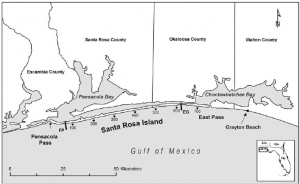
Citation: Morang, A. . A study of geological and hydraulic processes at East Pass, Destin, FL. Accessed: https://apps.dtic.mil/dtic/tr/fulltext/u2/a253890.pdf
“Foundation for a Gator Nation”
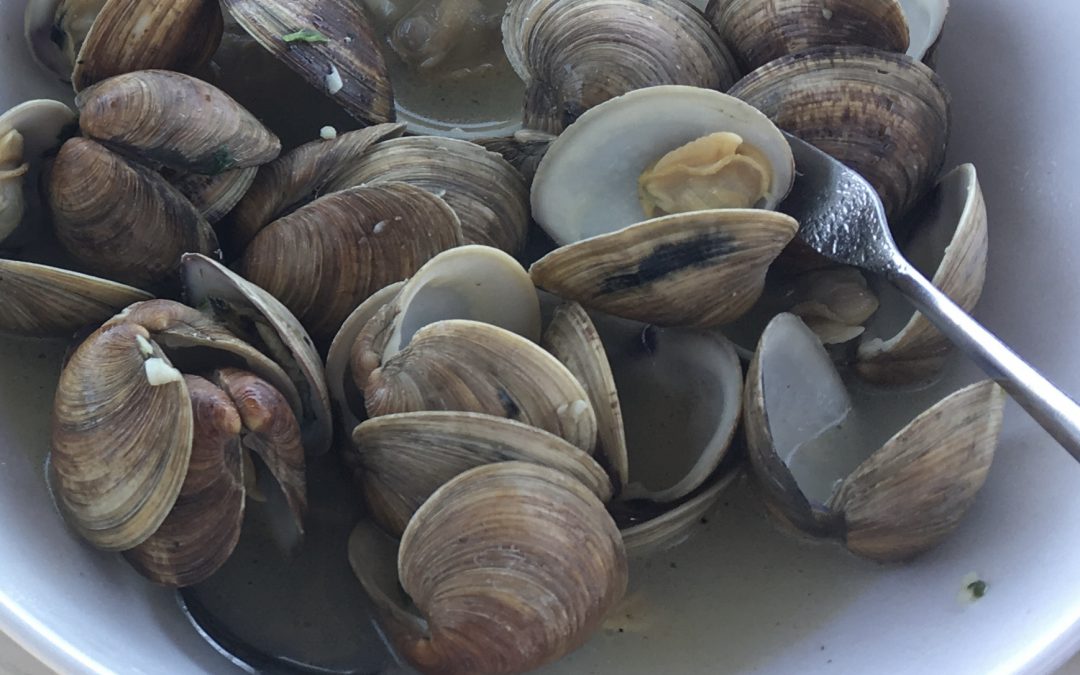
by Laura Tiu | Feb 12, 2021
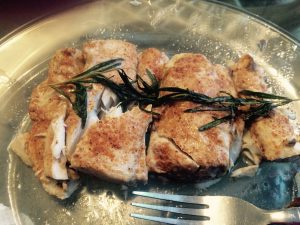
Cooked red snapper (Photo credit: L. Tiu)
It’s February and for many, our thoughts turn to romance and other things that make the heart happy, like seafood! There is a strong “love” connection between consuming seafood and heart health. Fish and shellfish are low in saturated fat, high in protein and fairly easy and quick to cook. But seafood has a secret weapon in the battle for our hearts as it is considered a good source of omega-3 fatty acids. The health effects of omega-3 fatty acids have been extensively investigated, and it appears that marine fish oil lowers triglycerides, boosts HDL cholesterol, provides other cardiovascular benefits, fights inflammation, and reduces blood clot formation.
The current recommendation from the American Heart Association is 1 to 2 seafood meals, 8 ounces or more, per week be consumed to reduce the risk of congestive heart failure, coronary heart disease, ischemic stroke, and sudden cardiac death, especially when seafood replaces the intake of less healthy foods. This translates into 250 to 500 mg of omega-3 per day or 1750 to 3500 mg per week. For the past 30 years, Americans’ weekly consumption of seafood has hovered around 5 oz per week, with only 10% to 20% of U.S. consumers meeting the 8 ounces minimal federal dietary guideline.
Historically, attention has focused on wild, cold-water, fatty fish like salmon, tuna, mackerel, and sardines as sources of the most omega-3 fatty acids. However, in this case variety is a key. With a growing number of aquaculture fish and shellfish on the market it is important to note that recent studies show for some species of salmon or trout, omega-3 levels are higher in farm-raised species, due to their overall higher fat content. In other good news, many of our local Gulf of Mexico species have been shown to contain good amounts as well. This information means that fishermen and women can eat home-caught fish to get the needed omega-3 fatty acids. Gulf fish are also an excellent source of protein and other nutrients. The following Table contains the omega-3 fatty acid content of some of the most frequently consumed fish and shellfish species in the U.S. So do your heart a favor and start feeding it right.
Omega-3 Content of Frequently Consumed Seafood Products
SEAFOOD PRODUCT
|
|
OMEGA-3s PER 3 OUNCE COOKED PORTION
|
| Herring, Wild (Atlantic & Pacific) |
♥♥♥♥♥ |
>1,500 milligrams |
| Salmon, Farmed (Atlantic) |
♥♥♥♥♥ |
| Salmon, Wild (King) |
♥♥♥♥♥ |
| Mackerel, Wild (Pacific & Jack) |
♥♥♥♥♥ |
SEAFOOD PRODUCT
|
|
OMEGA-3s PER 3 OUNCE COOKED PORTION
|
| Salmon, Wild (Sockeye, Coho, Chum & Pink) |
♥♥♥ |
500 to 1,000 milligrams |
| Sardines, Canned |
♥♥♥ |
| Tuna, Canned (White Albacore) |
♥♥♥ |
| Swordfish, Wild |
♥♥♥ |
| Trout, Farmed (Rainbow) |
♥♥♥ |
| Oysters, Wild & Farmed |
♥♥♥ |
| Mussels, Wild & Farmed |
♥♥♥ |
SEAFOOD PRODUCT
|
|
OMEGA-3s PER 3 OUNCE COOKED PORTION
|
| Tuna, Canned (Light) |
♥♥ |
200 to 500 milligrams |
| Tuna, Wild (Skipjack) |
♥♥ |
| Pollock, Wild (Alaskan) |
♥♥ |
| Rockfish, Wild (Pacific) |
♥♥ |
| Clams, Wild & Farmed |
♥♥ |
| Crab, Wild (King, Dungeness & Snow) |
♥♥ |
| Lobster, Wild (Spiny) |
♥♥ |
| Snapper, Wild |
♥♥ |
| Grouper, Wild |
♥♥ |
| Flounder/Sole, Wild |
♥♥ |
| Halibut, Wild (Pacific & Atlantic) |
♥♥ |
| Ocean Perch, Wild |
♥♥ |
| Squid, Wild (Fried) |
♥♥ |
| Fish Sticks (Breaded) |
♥♥ |
SEAFOOD PRODUCT
|
|
OMEGA-3s PER 3 OUNCE COOKED PORTION
|
| Scallops, Wild |
♥ |
< 200 milligrams |
| Shrimp, Wild & Farmed |
♥ |
| Lobster, Wild (Northern) |
♥ |
| Crab, Wild (Blue) |
♥ |
| Cod, Wild |
♥ |
| Haddock, Wild |
♥ |
| Tilapia, Farmed |
♥ |
| Catfish, Farmed |
♥ |
| Mahimahi, Wild |
♥ |
| Tuna, Wild (Yellowfin) |
♥ |
| Orange Roughy, Wild |
♥ |
| Surimi Product (Imitation Crab) |
♥ |
Source: USDA National Nutrient Database for Standard Reference
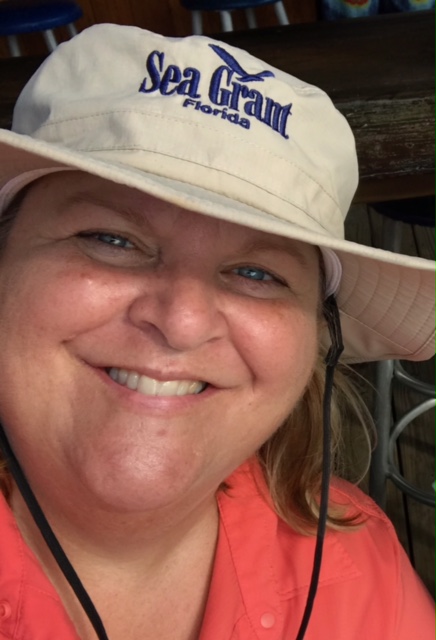
by Laura Tiu | Dec 18, 2020
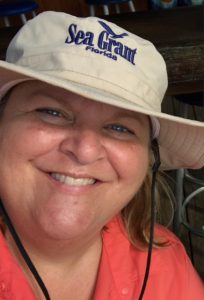
Laura Tiu, UF/IFAS Marine Science Agent
Laura Tiu is the Marine Science Sea Grant Agent with the University of Florida Extension Service in Okaloosa and Walton Counties. Raised in Sioux City, Iowa, she left the cornfields of the Midwest to pursue her dream of becoming a marine biologist, following in the footsteps of the infamous Jacques Cousteau. Living in the Philippines for four years was the educational experience of a lifetime, with adventures to the tops of mountains to the depths of the sea. She was fortunate to work on the very first marine preserve in the Philippines on Apo Island, which has since evolved into a scuba diver paradise.
Coming back stateside, her first professional job was as a fish breeder on a tropical fish farm in Plant City, Florida. This is where her passion for aquaculture was born. After a brief stint at Mote Marine Laboratory in Sarasota, Florida, Laura left for Mississippi State University where she earned a Master of Science degree in Wildlife Ecology, focusing on fisheries and aquaculture. Her thesis explored the impact of largemouth bass maternal size on survival of fry. Not one to follow a straight path, Laura joined the staff at Kentucky State University Aquaculture Program where she spent the next eight years doing fish nutrition work on multiple species including catfish, trout, hybrid striped bass, hybrid bluegill, paddlefish and freshwater prawn. This experience gave her a great appreciation and understanding how research can help grow the burgeoning aquaculture industry.
With a desire to do Extension work and a goal to continue her graduate work, Laura spent the next 18 years at The Ohio State University where she earned her Ph.D. in Extension Education while serving as Director of the Aquaculture Extension Program. She was responsible for supporting the development of a sustainable aquaculture industry in Ohio and throughout the Midwest. During her tenure, the number of aquaculture operations in Ohio increased from 30 to over 200, with many of the startups graduating from her Aquaculture Boot Camp program.
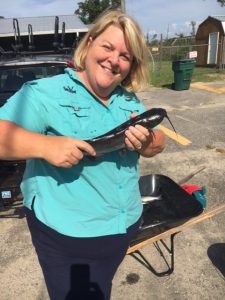
Harvesting catfish from the aquaponics system.
Circling back to her passion for marine science, Laura joined the University of Florida Sea Grant program in 2015. Her current programs include natural resource and environmental education and aquaculture. She provides programming in natural resource stewardship through the Florida Master Naturalist Program and Panhandle Outdoor Live, which offers interpretive, and now virtual, environmental education. She loves to educate clients about the awesome natural resources in the Panhandle including the farm ponds, numerous springs, creeks, rivers, estuaries, beaches, offshore reefs, and the coastal dune lakes of Walton County. She spends a good part of her summer helping with the 4-H marine camps at Camp Timpoochee in Niceville, FL. Her aquaculture passion remains strong through her work with a growing aquaponics community in the state.
Laura lives with her retired husband in DeFuniak Springs, FL where they enjoy fishing, kayaking, swimming and exploring the great natural resource areas in the Panhandle. She loves to play tour guide when her two grown sons, family and friends come to visit. “I just love to show off the natural beauty of our area and help others better understand what they can do to help protect our environment.”

Sunset on Okaloosa Island.
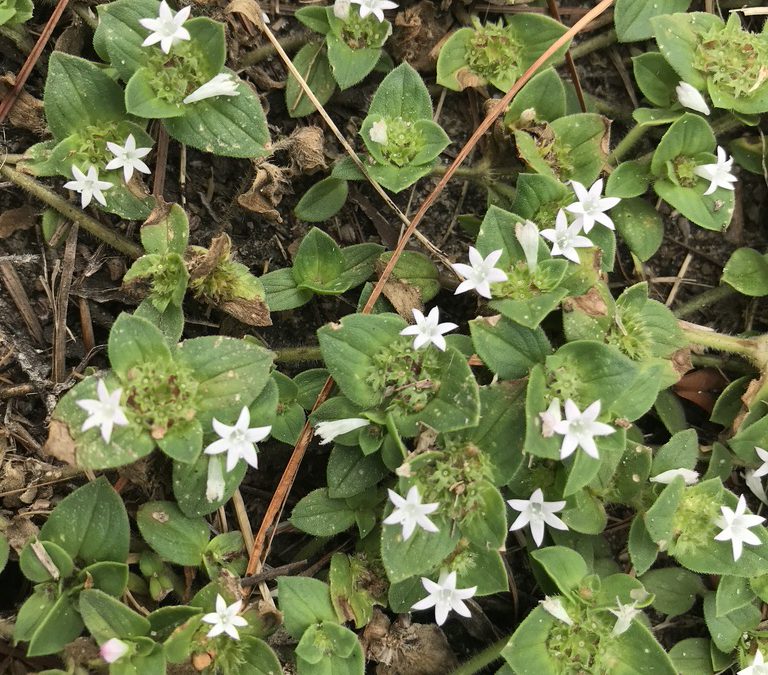
by Laura Tiu | Dec 3, 2020
Fall is such a spectacular time in the Florida Panhandle. The crowds are gone and the thermometer rests at a pleasant 50-70-something degrees. It is the perfect time of year to enjoy our amazing environment. Nature has a magical way of boosting our energy levels and immune systems and improving mood and focus. We can all use a heaping helping of that right now.
So where do you start? Here are some ideas.
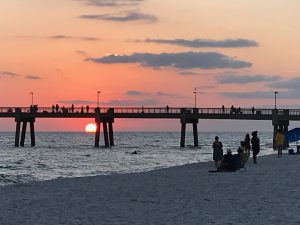 Take in a sunrise or sunset. The beach is often one of the best places to do this, but anywhere will do. Last weekend, I was at the Okaloosa Island Boardwalk and Pier and the sunset was magnificent. While there, take a walk along the beach, let the cool sand squish between your toes and discover what might be hiding in the wrack. The wrack is that line of seaweed deposited after high tide. Upon close inspection, it contains many treasures including seagrasses, sponges, shells, worm tubes, small crabs and other oddities.
Take in a sunrise or sunset. The beach is often one of the best places to do this, but anywhere will do. Last weekend, I was at the Okaloosa Island Boardwalk and Pier and the sunset was magnificent. While there, take a walk along the beach, let the cool sand squish between your toes and discover what might be hiding in the wrack. The wrack is that line of seaweed deposited after high tide. Upon close inspection, it contains many treasures including seagrasses, sponges, shells, worm tubes, small crabs and other oddities.
Take a nature hike. I love the nature trails at our local state and national parks, Henderson Beach, Topsail, Blackwater and Grayton Beach State Parks all have great trails. You may see some wildflowers this time of year. Look for animal tracks and resident birds. You may also see some monarch butterflies on the saltbush, resting as they continue their migration to Mexico.
Check out the springs. Morrison Springs and Ponce de Leon Springs in the state park in Walton County are an easy drive. Sit and enjoy the beauty and peaceful nature that surrounds the springs. Dip your toes in the cool water for a refreshing tingle or jump right in if you dare.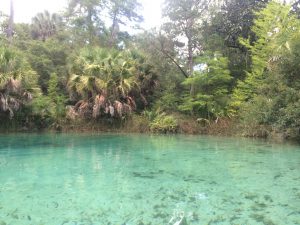
If you have a kayak, canoe or paddle board, it’s a great time to be on the water. Look for migrating shorebirds, schools of fish or pods of dolphins. Did you know we have over 60 dolphins that call the Destin area home year-round? You can often find them cruising in the Choctawhatchee Bay, or hop aboard one of our local dolphin cruises to catch a better glimpse.
Finally, our local fresh seafood is available year-round. Plan a picnic with some fresh shrimp or smoked mullet dip. Seafood offers many of the same benefits as time in nature, so double up on all the goodness that fall has to offer. Get outside and get happy!
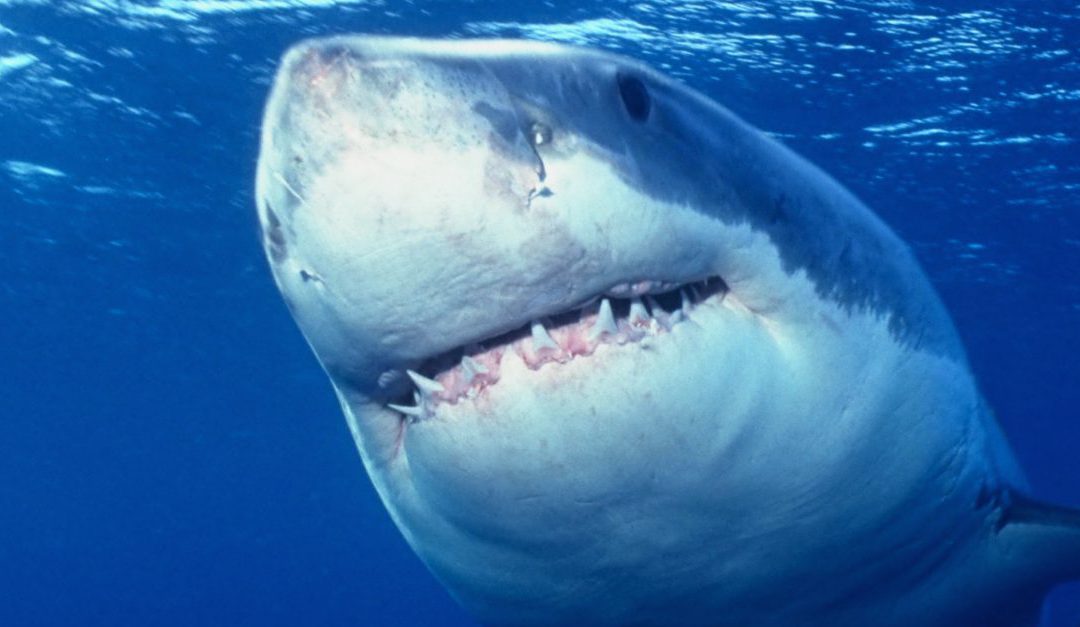
by Laura Tiu | Sep 11, 2020
When one thinks of the Emerald Coast, visions of sparkling water, baby-powder beaches, rental houses and high-rises interwoven with seafood and pizza restaurants appear. The coast is dotted with fishing boats, pirate ships and dolphin cruises and the beaches are littered with people. But it is what glides under the water that some people are curious about. “Are there sharks in the water here?” is a question I often get from locals and tourists alike. The answer is yes, sharks call saltwater home.
Sharks evoke a variety of emotions in people. Some folks are fascinated and list shark fishing and diving with a shark on their bucket lists. Others are terrified, convinced that sharks only exist to hunt them and bite them while they take a swim. Unfortunately for the sharks, their appearance plays into this later fear, with sharp teeth, unblinking eyes and sleek bodies. The reality is that most sharks only grow up to three feet in length and eat small shrimp, crabs and shrimp, not humans. But it is true that bull, tiger and great white sharks are all large species that have been known to attack humans.
Of the 540 different species of sharks in the world, there are about twelve that call the Emerald Coast home including Atlantic sharpnose, bonnet head, blacktip, bull, dusky, great white, hammerhead, nurse, mako, sand, spinner, and tiger. They don’t all stick around all year, with some migrating south in the winter, while others migrate north.
Sharks use their seven senses to interpret their environment: smell, sight, sound, pressure, touch, electroreception, and taste. Most shark attacks occur when a human is mistakenly identified as prey. There are some easy measures you can take to reduce the risk.
- Swim with others, this may intimidate sharks and allows someone to go for help if a bite occurs.
- Remove jewelry as it can look like an attractive shiny fish underwater.
- Don’t swim where folks are fishing as bait in the water may attract sharks.
- Pay attention to any schools of baitfish in the area that may be attracting sharks.
- Do not swim at dusk or dawn when visibility may be poor.
- Learn how to identify various shark species
Remember, shark attacks on humans are rare. Reports of stepping on stingrays, jellyfish stings, lightning, dangerous surf conditions and car accidents greatly outnumber the number of shark attacks every year.
For more information: https://www.floridamuseum.ufl.edu/sharks/education-resources/
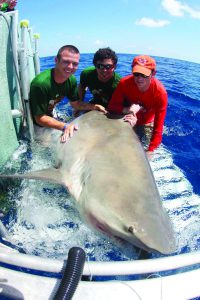
A bull shark being tagged by researchers (credit: Florida Sea Grant).
“An Equal Opportunity Institution”











 Take in a sunrise or sunset. The beach is often one of the best places to do this, but anywhere will do. Last weekend, I was at the Okaloosa Island Boardwalk and Pier and the sunset was magnificent. While there, take a walk along the beach, let the cool sand squish between your toes and discover what might be hiding in the wrack. The wrack is that line of seaweed deposited after high tide. Upon close inspection, it contains many treasures including seagrasses, sponges, shells, worm tubes, small crabs and other oddities.
Take in a sunrise or sunset. The beach is often one of the best places to do this, but anywhere will do. Last weekend, I was at the Okaloosa Island Boardwalk and Pier and the sunset was magnificent. While there, take a walk along the beach, let the cool sand squish between your toes and discover what might be hiding in the wrack. The wrack is that line of seaweed deposited after high tide. Upon close inspection, it contains many treasures including seagrasses, sponges, shells, worm tubes, small crabs and other oddities.

